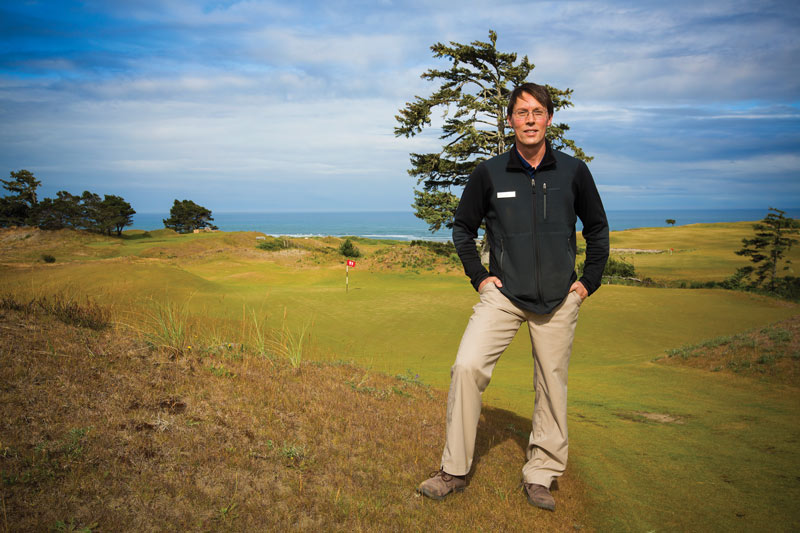
Broken Sound Club in Boca Raton, Fla., is overseen by Shannon Easter, director of golf maintenance and environmental consultant, who is the winner in the Overall and National Private categories of the 2016 Environmental Leaders in Golf Awards. Photo by Kyle Asbury
The Environmental Leaders in Golf Awards — presented annually by GCSAA and Golf Digest, in partnership with Syngenta and Rain Bird’s Golf Division — recognize golf course superintendents and their courses for overall course management excellence and best management practices in the areas of water conservation, water quality management, integrated pest management, energy conservation, pollution prevention, waste management, wildlife and habitat conservation, communication and outreach, and leadership. Here, the year’s top honorees share their stories, strategies, and points of greatest pride as environmental stewards.

Shannon Easter alongside Broken Sound’s in-vessel composter. Photo by Kyle Asbury
Shannon Easter
Broken Sound Club
Boca Raton, Fla.
Overall + National Private winner
Of all the commercial entities in the 65,758 square miles that make up the state of Florida, Broken Sound Club in Boca Raton has a recycling rate that, according to the Florida Department of Environmental Protection, ranks among the best. How does the 1,000-acre club, which features 23 tennis courts, a fitness center and spa, a handful of dining facilities, and a pair of 18-hole courses, pull off such a feat? Director of golf maintenance and environmental consultant Shannon Easter chalks it up to planning, dedication, and the help of a state-of-the-art, 42-foot-long on-site composter.
“All the club’s yard waste and food waste — either from food being prepared or what people don’t eat — goes into it,” says Easter, describing what’s known as the environmentally controlled waste system, or ECW, which was installed six years ago by the club’s previous superintendent, Joseph Hubbard, CGCS. What comes out after five days and about a week spent curing on a nearby plot is a supply of nutrient-rich compost ready to be returned to nourish the terrain, allowing for a full-circle life cycle for the courses’ yard refuse. “We’re able to recycle 95 percent of everything on property,” says Easter, who adds that the ECW alone diverts 500,000 pounds of food waste and 1.2 million pounds of yard waste from the landfill each year, also saving the club substantially on waste disposal expenses while putting a dent in its fertilizer, mulch and pesticide costs.
For Easter, garnering recognition as a model facility for recycling or, most recently, as the Overall and National Private winner in the 2016 Environmental Leaders in Golf Awards are immense honors, yet the quest to cultivate an ecologically abundant oasis with the lowest possible footprint right in the middle of downtown Boca Raton is an ongoing objective, a persistent passion. “We want to continue to be the leader in sustainability,” says Easter, a 19-year member of GCSAA. “Every project that arises, we look at how we can use it to positively affect the environment, instead of, ‘How do we not hurt the environment?’ How do we make it better than what we started with?”
What Easter started with when he took the reins at Broken Sound five years ago was two Joe Lee-designed courses — the Old Course, founded in 1978 and host to the annual PGA Champions Tour Allianz Championship, and the Club Course, opened in 1985 — already being maintained to high environmental standards thanks to the groundwork laid by Hubbard (currently the superintendent at Boca Delray Golf & Country Club in Delray Beach, Fla.). The area’s subtropical climate and sandy, well-drained soil spawn an assortment of lush vegetation that in turn fosters a veritable menagerie of wildlife, from iguanas to raccoons to several species of wading birds that waltz about the 28 lakes on the premises. Easter, a Florida native who graduated from Lake City (Fla.) Community College (now Florida Gateway College) in 1996 with a degree in golf and turf management, made it his goal to keep striving for even greater gains in conscientious management.
A big opportunity came with the 2014 renovation of the Old Course. Although the impetus for the project was long-standing agronomic issues, Easter seized the chance to improve water conservation and quality. He experimented with topically applying a carbon filtration product to better hold water and nutrients in the soil, keeping both available to the turfgrass longer while also better filtering out impurities before the water reaches the watershed. The trials were successful, and Easter eventually implemented the tactic course-wide, which has led to cuts in both the course’s water and fertilizer needs.
Now, with the renovation of the Club Course beginning this spring, Easter plans to incorporate the carbon filtration product directly into the soil profile throughout the entire course (which, like the Old Course, has TifEagle bermudagrass greens, Sea-Dwarf seashore paspalum tees and Celebration bermudagrass fairways), with the aim of achieving even larger reductions in water and fertilizer use.
The Club Course renovation will also introduce a new irrigation system design to account for freshly converted native areas, butterfly gardens and buffer zones (over the past five years, 17 acres of high-maintenance turf have been removed from the two courses). The update will eliminate 16 irrigation heads and swap 113 full-circle heads for partial-circle heads. The result will be a savings of 7.5 million gallons of water per year.
Broken Sound enlists several other strategies to ensure the most sensible use of water, including yearly course mapping and irrigation audits to assess wet/dry spots, monthly irrigation head inspection, daily use of moisture meters, sensors that shut down the two courses’ irrigation systems following a half-inch of rain, and sophisticated controls that automatically adjust sprinklers based on evapotranspiration. The Club Course also features an extremely efficient pump station with three variable-frequency drive (VFD) motors, which has slashed the course’s power costs by 42 percent. (An identical station will be installed for the Old Course in the next few years.)
Easter, whose team consists of 46 employees who keep the courses pristine for year-round play, says educating the club’s membership about environmentally beneficial modifications around the property has been an important part of his work. A prime example? The steady addition of numerous acres of wildflowers. “There are times when the flowers don’t look quite as beautiful, but the bees and butterflies are still foraging and using them for shelter, so they’re an important part of the ecosystem,” Easter says. “We want to help members understand that.” Through such communication, which includes meetings just for members to chat with Easter, the superintendent says Broken Sound’s clientele has become equally invested in its mission of utmost environmental responsibility.
As for the ecosystem-enriching accomplishment he’s most proud of, Easter points to Broken Sound’s 22 beehives (which also took some convincing to launch, assuring members they wouldn’t get stung). While the resident honey bees produce sweet rewards in the form of more than 1,500 gallons of their golden elixir each year, Easter says he has drawn satisfaction simply from seeing the setup thrive throughout the past four years — a firsthand counter to the notion that pollinators and golf courses can’t coexist. (And, to date, no members have been stung.)
Among initiatives in the works at Broken Sound are assisting with the conservation of the endangered Florida bonneted bat, and installing five wind turbines that will provide all power for the restrooms on the Club Course as well as partially tackle the electricity needs of that course’s maintenance facility. Easter says his tenacity for pursuing new and ambitious environmental endeavors is born of both a deep-rooted love for the outdoors and a personal desire to combat the misperceptions many people have regarding golf’s impact on the environment. “I’m determined to prove people wrong,” Easter says. “I want to prove that golf courses can actually be the most environmentally friendly areas.”

Alex Stuedemann (center), pictured with assistant superintendents Jonathan Graham (left) and Tony Gustafson. Photo courtesy of Alex Stuedemann
Alex Stuedemann
TPC Deere Run
Silvis, Ill.
National Public winner
For Alex Stuedemann, director of golf course maintenance operations at TPC Deere Run, solid environmental stewardship doesn’t just lie in the details, but in the scrupulous, ongoing analysis of those details. While meticulous observation and the ability to make swift adjustments are essential tools in any turf manager’s kit, the peculiar conditions at Stuedemann’s home turf — located in the city of Silvis, Ill., part of the Quad Cities metropolitan area in northwestern Illinois and southeastern Iowa — render such know-how all the more imperative.
“It can be sunny and 80 degrees on the Iowa side while there’s a severe thunderstorm and 3 inches of rain on the golf course,” says Stuedemann. “The microclimates we have throughout the course itself are another big challenge, because we can’t have one set of plays that we go out with every day. We do a lot of forecasting, and we have to be flexible.”
Indeed, anything resembling a “one-size-fits-all” or “set-it-and-forget-it” approach simply won’t fly at the 18-hole TPC Deere Run, and the resultant vigilant monitoring produces insights that allow for exceptionally prudent use of water, pesticides and other inputs throughout the course’s creeping bentgrass greens, tees and fairways. “We’re able to see how we can work with the golf course to provide a plant that’s healthy on its own — that doesn’t need a pounding of inputs,” says Stuedemann, who hails from Minnesota and earned a degree in environmental horticulture from the University of Minnesota.
Last summer, for example, brought an influx of rain and high humidity, which Stuedemann says led to the release of nutrients from organic matter in the soil. “We had fertilizer that we’d planned on applying, but we stepped back and said, ‘The grass is healthy — the soil testing is confirming that — so let’s leave the fertilizer in the facility,’” he says.
That commitment to listening to the land and thoughtfully solving any puzzle it may put forth is no doubt driven by Stuedemann’s desire to furnish top-notch turf at TPC Deere Run, designed by D.A. Weibring and host to the annual John Deere Classic since 2000. His resolve is heightened, however, by his reverence for the space with which he has been entrusted. The 400-acre expanse of Midwestern prairie was previously an Arabian horse farm owned by descendants of John Deere, who donated the land to the PGA Tour in the 1990s for the purpose of preserving it and creating a golf course that would be a showcase of environmentally beneficial management.
In addition to its John Deere family ties, the tract is also the site of Native American burial grounds, a fact Stuedemann has taken special care to acknowledge and honor, connecting with the chief of the local tribe and asking him to visit and perform a blessing. “It was enlightening to listen to him talk about the history of his tribe and the significance of us preserving these burial grounds,” Stuedemann says. “It integrates well with how we maintain this property.”
That maintenance regimen features particular attention to water, a focus Stuedemann sharpened while working on the construction of TPC San Antonio from 2007 to 2012. During grow-in, the region of Texas was experiencing a drought, and the facility had to adhere to a strict daily allotment of water. By the time Stuedemann returned to TPC Deere Run to assume the head superintendent position in 2014 (he had previously worked there as an assistant superintendent from 2002 to 2007), those lessons in water frugality had become ingrained, and the course employs a wealth of water-conserving measures — everything from advanced weather station technology that accommodates the precise irrigation needs of each microclimate to the regular evaluation of nozzles, which eliminates any non-target watering.
While judicious water use is standard protocol for greenkeepers nowadays, Stuedemann also turns his shrewd eye to matters beyond agronomy. In the maintenance building, you’ll find supplies purchased in bulk to trim waste output, biodegradable equipment and facility cleaners, LED light bulbs, and weather-tight exterior doors. Just switching from the old hollow-core doors has resulted in a 3 to 5 percent energy savings every month, Stuedemann says — yet another example of the attention to detail that the 18-year GCSAA member hangs his hat on.
“Whether it’s replacing inefficient light fixtures or putting a bead of caulk around a vent stack, you’ve ultimately just made a big difference in your energy consumption,” says Stuedemann, who credits Cal Roth, senior vice president of agronomy for the PGA Tour, and Collier Miller, TPC senior director of agronomy, with setting high standards of environmental attentiveness across all TPC Network properties. “For us, it’s not ‘Hey, we’re going to be eco-friendly on the golf course, but not anywhere else.’ The mentality applies to every aspect from the time you walk in until the time you walk out, and the little things add up. Not everything has to be a flashy, big-budget initiative.”

Photo courtesy of Bandon Dunes Golf Resort
Ken Nice
Bandon Dunes Golf Resort
Bandon, Ore.
National Resort winner
On the namesake sand dunes of Bandon Dunes Golf Resort in southern Oregon resides a tremendously rare botanical beauty known as silvery phacelia (Phacelia argentea), found only along about a 130-mile stretch of Oregon and California coastline. The stout-stemmed, silvery-leaved perennial herb easily gets pushed out by non-native plants, and is currently classified as “threatened” by the state of Oregon and as a “species of concern” by the federal government.
The imperiled dune-dweller’s presence at the 3,300-acre resort represents a small but special victory for Bandon Dunes director of agronomy Ken Nice and his staff of about 90, who maintain four 18-hole courses (Bandon Dunes, Pacific Dunes, Bandon Trail and Old Macdonald, all on Golf Digest’s list of “America’s 100 Greatest Golf Courses”) and one 13-hole par-3 course (Bandon Preserve). “For all of us, it’s a passion,” says Nice of the Bandon Dunes agronomy team’s environmental commitment. “We try to learn and keep changing as needed, finding things we can do better.”
Care for silvery phacelia is a microcosm of the deliberate and dedicated stewardship that unfolds throughout Bandon Dunes, laid out in harmony with the grassy dunes, pine forest and stunning Pacific seascapes. Nice and his staff employ a spoon-feeding approach to fertilizer — using almost exclusively liquid fertilizers in increments as small as one-tenth of a pound per application — to safeguard against runoff and leaching while delivering turf (primarily fine fescue) exactly what it needs. They return the grass clippings from 80 percent of the course to biodegrade and replenish the soil. They’ve left a vacant shed on the Bandon Trails course to provide a welcoming roost for bats. And they diligently manage gorse (Ulex europaeus), an invasive, non-native shrub whose tall, dense, thorny growth entails not only somewhat labor-intensive removal but also close supervision. “It can take over a whole landscape. It’s impenetrable and flammable, so it adds that existing fire hazard,” Nice says. “It’s a constant management process for us.”
Battling aggressive plants aside, Nice says a day-to-day approach to course upkeep that’s discerning, minimalist aligns well with Bandon Dunes’ mission. “Our main goal is to provide authentic links conditions, which you don’t really see in the United States,” says Nice, a 20-year GCSAA member. “In providing firm, fast links conditions, it follows suit that you’re doing a lot of environmentally sound things — being frugal with all of your inputs. The two go hand in hand.”
Along with unique flora, Bandon Dunes is home to some distinct agronomic challenges, a significant one being the strong coastal winds during summer, which can wreck distribution uniformity and therefore make having a good hand-watering program critical in order to avoid ramping up run times. Another challenge is purely the size of the operation. For this reason, Nice — whose team includes superintendents Jeff Wilson (Bandon Dunes course), Jeff Sutherland (Pacific Dunes), Scott Huntley (Bandon Trail and Bandon Preserve) and Fred Yates, CGCS (Old Macdonald) — emphasizes training, a fact that’s well illustrated in the execution of the resort’s integrated pest management plan. Every member of the agronomy staff is trained to identify potential pest problems and take immediate control measures if feasible. The findings are then documented and the issues monitored. “You want to be able to have multiple eyes looking for the same things,” says Nice. “If you can get the entire crew to be on the same page, it’s a win for every area.”
And then there’s Bandon Preserve, the most recent addition to the resort’s golf offerings, from which all net proceeds go to the Wild Rivers Coast Alliance, a philanthropic organization focused on the conservation, communities and economy of Oregon’s southern coast. Each of the course’s 13 holes boasts an ocean view, and even its scorecard is eco-centered, informing players of some of the resort’s stewardship activities.
Further environmental efforts abound, from renewable energy (four solar arrays) to recycling (the resort is an EPA WasteWise Partner), and while all of this adds up to an impressive catalog of achievements, Nice says thinking green is simply second nature at Bandon Dunes. He attributes the mindset to the resort’s owner, Mike Keiser, and management company, KemperSports Management, who he says encourage a culture of environmental conscientiousness from the top down. “We’re lucky that we have a place where we can do this kind of thing,” says Nice, who grew up 115 miles away in Corvallis, Ore., and is a graduate of Oregon State University. “Knowing that we have the support of our owner and management company frees us up to do the things that are right.”
What wisdom would this environment-minded turf manager pass along to those just getting started in the profession? “The tendency for young turf managers is to come in and want to do lots of things. You went to school — you want to do the things you learned. But you need to be really thoughtful of your inputs,” Nice advises. “Scrutinize, and ask yourself, ‘Do I really need to apply this? Is this essential?’ See what your environment and the golf course need, and go from there. If you can cut some things that aren’t necessary, cut them.”

Photo courtesy of The Jockey Club Kau Sai Chau
Christine Chan
The Jockey Club Kau Sai
Chau Public Golf Course
Hong Kong
International winner
When Christine Chan was growing up in a small farming village in rural Hong Kong, admiring the verdant swaths of turfgrass at Hong Kong Golf Club whenever she would pass by, the site of her future place of employment, The Jockey Club Kau Sai Chau Public Golf Course, was sitting battered and abandoned — inhospitable to people, plants and animals. Located on the island of Kau Sai Chau, northeast of Hong Kong, the land was formerly military training ground, in use from 1936 to 1975 and bearing heavy scars from aerial bombing, artillery shells and hill fires.
These days, with Chan at the helm as superintendent, the operation of the three 18-hole golf courses composed on the island — the North and South courses, designed by Gary Player and opened in 1995, and the East Course, the work of architecture firm Nelson & Haworth, added in 2008 — has revitalized the once-desolate space into both a bustling business and an ecological sanctuary. “Golfers share 250 hectares with eagles, egrets and pond herons, as well as the occasional barking deer, leopard cat, native boar, civet and porcupine,” says Chan, a 21-year GCSAA member, who notes that a recent survey of the property found that the presence of the courses (which occupy 617 acres, a total of about 42 percent of the island) has boosted Kau Sai Chau’s biodiversity.
With its sweeping panoramas of the Sai Kung Peninsula, The Jockey Club Kau Sai Chau, initiated by the Hong Kong government and Hong Kong Jockey Club in 1994, is indeed a striking testament to golf course development as a means of environmental revitalization.
It’s also a hub for the sport. As the only public golf facility in Hong Kong, The Jockey Club Kau Sai Chau sees more than 200,000 visitors annually, and its patrons arrive at the exemplar environmental facility in apt fashion — via solar-powered ferries. Through its fleet of golf carts outfitted with solar panels, Chan says the facility is able to reduce its dependence on grid power even further.
A cornerstone of the courses’ sustainability is the self-sufficient irrigation setup. “The golf courses are constructed to effectively collect and store rainwater in reservoirs and recycle it as irrigation water for the turfgrass,” says Chan, who has overseen the maintenance of The Jockey Club Kau Sai Chau since 2005. “About 70 percent of the North and South courses return rainfall to the reservoir. The newer East Course has been designed with a full closed drainage system, providing 100 percent return through a system of five underground tanks and two lakes.” The Jockey Club Kau Sai Chau also has its own sewage treatment plant, and the effluent is given second life as irrigation for the courses.
For Chan, who studied environmental science at Hong Kong Baptist University and earned a master’s degree in turf management from the University of Sydney, the greatest challenge she faces in her role at The Jockey Club Kau Sai Chau is keeping the turfgrass first-rate year-round given Hong Kong’s limited hours of sunlight in winter and spring — which also happen to be the peak seasons for golf. Despite the demands and the island’s already remarkable turnaround, her approach remains steeped in stewardship, not only for the health of the land itself, but for the benefit of those who make that ferry trip. “Golfers can breathe fresher air here while experiencing healthy surroundings,” Chan says. “It reduces the stress of a routine urban life — especially in Hong Kong.”
More ELGA honorees
Along with the quartet of recipients in the national and international categories, 19 chapter winners and nine merit winners were chosen from GCSAA’s 98 affiliated chapters.
Chapter winners
Mahmud Ayeb
Mather Golf Course
Mather, Calif.
Sierra Nevada GCSA
Michael Bednar
Palouse Ridge Golf Club
Pullman, Wash.
Inland Empire GCSA
Anthony Benes
Old Works Golf Course
Anaconda, Mont.
Peaks & Prairies GCSA
Timothy Connolly
TPC Jasna Polana
Princeton, N.J.
GCSA of New Jersey
Jorge Croda, CGCS
Southern Oaks Golf Club
Burleson, Texas
North Texas GCSA
Matthew Gourlay, CGCS
Colbert Hills Golf Course
Manhattan, Kan.
Heart of America GCSA
Dale Hahn, CGCS
TPC Summerlin
Las Vegas
Southern Nevada GCSA
Gary Ingram, CGCS
Metropolitan Golf Links
Oakland, Calif.
California GCSA
Mark Kosbab, CGCS
Sportsman’s Country Club
Northbrook, Ill.
Midwest Association of GCS
Jay Neunsinger
Boundary Oak Golf Course
Walnut Creek, Calif.
GCSA of Northern California
Kurt Noonan, CGCS
Juniper Golf Course
Redmond, Ore.
Oregon GCSA
Sean O’Brien, CGCS
The Ritz-Carlton Members Golf Club
Sarasota, Fla.
Sun Coast GCSA
Brandon Reese
TPC Louisiana
Avondale, La.
Louisiana-Mississippi GCSA
Jeff Reich
TPC River Highlands
Cromwell, Conn.
Connecticut Association of GCS
J. Cutler Robinson, CGCS
Bayville Golf Club
Virginia Beach, Va.
Virginia GCSA
Jim Thomas, CGCS
TPC Southwind
Memphis, Tenn.
Tennessee GCSA
Carl Thompson, CGCS
Columbia Point Golf Course
Richland, Wash.
Inland Empire GCSA
Mark Trenter
Chambers Bay
University Place, Wash.
Western Washington GCSA
Jonathan Williams
Sewailo Golf Club at Casino Del Sol Resort
Tucson, Ariz.
Cactus & Pine GCSA
Merit winners
Mark Condos
Las Positas Golf Course
Livermore, Calif.
GCSA of Northern California
Dave Davies, CGCS
TPC Stonebrae
Hayward, Calif.
GCSA of Northern California
Robert Esposo
Pacific Grove Golf Links
Pacific Grove, Calif.
GCSA of Northern California
Jason Haines
Pender Harbour Golf Club
Madeira Park, British Columbia
Gary Heath
Glendoveer Golf & Tennis
Portland, Ore.
Oregon GCSA
Ron Kuhns
Sun Willows Golf Course
Pasco, Wash.
Inland Empire GCSA
Alan Nielsen, CGCS
Royal Oaks Country Club
Vancouver, Wash.
Oregon GCSA
Darin Pakkala
Crystal Springs Golf Course
Burlingame, Calif.
GCSA of Northern California
Jeremy Payne
Napa Golf Course
Napa, Calif.
GCSA of Northern California
Megan Hirt is GCM’s managing editor.